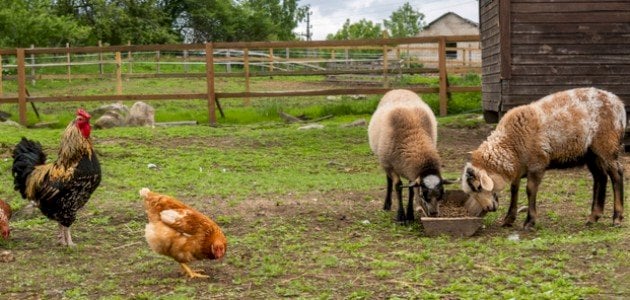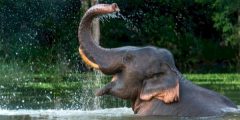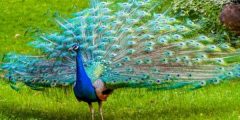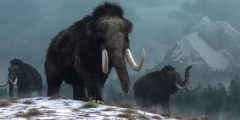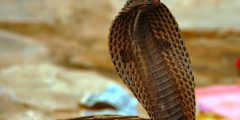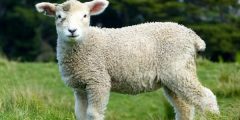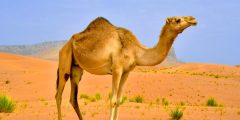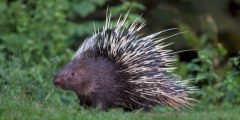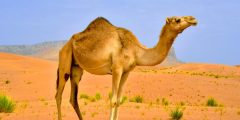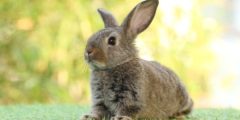Meaning of domestication of animals
Meaning:Domestication of animals (In English: Domestication) The process of adapting and raising certain types of animals and caring for them by humans so that they are suitable and usable for humans and that they interact and adapt with them with ease, and transform them from a wild animal of its various types into a domesticated animal.[XNUMX]
The domestication of animals aims to utilize these animals for food (meat, milk, and eggs), medicine, clothing, storage, building tents and houses, guarding, transportation, and many other uses.[XNUMX]
Benefits of domesticating animals
Humans raised domestic animals (pets) mainly to benefit from them as food and to get rid of the obligation of them to go hunting frequently, and with the development of the domestication of animals and the increase in their numbers, they became possible to benefit from them in many other fields, such as:[XNUMX]
Saving consumer resources
Domestic animals provide the main foodstuffs that humans need, including meat products, eggs, dairy products, fats, minerals, vitamins and carbohydrates. Domestic mammals produce large quantities of consumables that are beneficial to humans, most notably cows, goats, and various birds.[XNUMX]
During modern times, fish and marine animals were bred and widely consumed for food.[XNUMX]
Read also:Raising peacocks at home
Providing industrial resources
Domestic animals provide many of the raw materials used in manufacturing, and the two most important materials used since ancient times are wool and leather. Animals also provide bones and ivory for use in clothing buttons, and feathers for use in lining home furniture.[XNUMX]
Animal dung has long been used as fertilizer, fuel for cooking and heating, etc., as well as building materials and generating methane gas.[XNUMX]
Harnessing its power for various works
Domesticated animals are used in many different jobs. Large animals such as buffaloes, horses, donkeys, elephants and reindeer are very useful for ploughing, harvesting and transport; They are inexpensive compared to expensive machines, and they have great flexibility in movement, especially in narrow areas.[XNUMX]
food storage
Herds of livestock are used as a reserve store of food and nutrients for times when food is cut off and unavailable, whether as food or by storing food in their skins. These animals also consume surplus fodder and grains.[XNUMX]
Used in ceremonies
Domestic and domestic animals have been used in celebrations for a long time, such as the use of dogs dressed in decorated costumes at the Venice Carnival in Italy.[XNUMX] Many of these animals, in addition to their breeding, had a valuable participation in celebrations of marriage, birth, or death in several countries and cultures, in addition to their participation in religious rituals.[XNUMX]
Read also:Where did dinosaurs live?Horse shows added large numbers of spectators on official occasions and ceremonies. The main chariots were decorated and pulled to add much beauty to these celebrations.[XNUMX]
During the inauguration parades of a new president in the United States of America, one of the main activities was horsemen, cowboys, and Indians riding on horses, and when a new president was appointed, died, or ended his rule, he was transported in a carriage drawn by decorated horses.[XNUMX]
A source of entertainment
Animals have been used for thousands of years as a source of entertainment; The rulers of ancient civilizations collected rare and powerful animals as a symbol of power and wealth. In the Middle Ages, dogs and roosters were used for wrestling shows, and many domestic and wild animals were used in circuses in entertainment shows to earn money.[XNUMX]
Research
Domestic animals are used in scientific research, drug development, ensuring the effectiveness of medicines and products, and ensuring the effectiveness of cosmetics. Their use is due to the great similarity of some of their composition to that of humans. For example, repeated scientific research on the pancreas of dogs led to the discovery of insulin in the early twentieth century AD.[XNUMX]
provide protection
One way to benefit from animals is to use a large group of them to guard humans and their herds of livestock to protect them from theft and predators.[XNUMX]
Read also:Information about elephantThe most important domestic animal used in this task is the guard dog. There are many types of dogs used for human and animal protection. After training, they can work with any type of livestock and attack any potential danger to protect these herds.[XNUMX]
Human companionship
Raising pets and domestic animals is very beneficial for human mental health. It increases his activity, the rate of going out, and his social contact with others. It also helps lower blood pressure, triglycerides, and cholesterol, and is very useful for elderly people to reduce their loneliness.[XNUMX]
To get rid of unwanted objects
Animals play an important role in getting rid of unwanted organisms, especially birds that devour insects and help get rid of pests. The most important of these birds are:[XNUMX]
- Guinea fowl
Guinea fowl eat a lot of insects, and among these insects are deer ticks, which cause a high percentage of Lyme disease. Moreover, these chickens reduce the damage of chemical insecticides because there is no need to spray in large quantities to get rid of grasshoppers, worms, and spiders.
- Turkey
Turkeys eat insects in the spring, such as grasshoppers, weevils, caterpillars, ticks and spiders, which reduces the damage of these unwanted insects.
- ducks
Ducks help get rid of insects and pests, and they specialize in eating mosquitoes directly from the air, and eating larvae from plants.
It is believed that the only animal that specializes in hunting mice is the cat, but it turns out that there are several types of dogs that do this, including breeds: the Rat Terrier, the Yorkshire Terrier, the Norfolk Terrier, and the Dachshund. German Pinscher dogs.[XNUMX]
History of animal domestication
The domestication of animals began thousands of years ago, and domesticated animals began to live and be raised in a family system consisting of a herd ready to reproduce, naturally.[XNUMX]
The first animals raised by humans were mammals that produced milk and meat, such as cows, sheep, goats, and pigs. Humans also raised birds to benefit from their meat and eggs, such as chickens and turkeys. They also domesticated dogs, horses, and small cats.[XNUMX]
Wolves
Wolves are similar to ancient humans in the way they hunt and live. Wolves live in family tribal groups under the control of the important male head of the tribe, often followed by a female partner who enjoys authority after him. Members of the wolf tribe are very friendly with each other, but harsh with strangers.[XNUMX]
Many legends have been told that tell stories of children being suckled by wolves, a great metaphor for the convergence of means of subsistence and hunting.[XNUMX]
It is very difficult to trace the direct DNA of ancient wolves. This constituted an obstacle in knowing how wolves were domesticated in ancient times, but with the increasing pace of research, it is believed that the ancient wolves from which hunting and herding dogs evolved have become extinct, and that these wolves are originally from Asia, Europe, and the Near East.[13]
dogs
The dog is known as the oldest creature domesticated to serve humans in history. The oldest bones of a domesticated dog date back about 12 thousand years, and these remains were found in a cave in Iraq. The dog differs greatly from the wolf in its composition. It has smaller teeth and jaws, and is an obedient and friendly animal.[XNUMX]
Many pictures and sculptures belonging to ancient civilizations reveal many images describing the types of dogs domesticated by humans to help them guard and hunt.[XNUMX]
Livestock
Humans domesticated livestock in the period between 7-9 thousand BC. The first of these livestock were sheep and goats in the Middle East. A large amount of sheep bones were found in a large colony in northern Iraq. Other livestock that were domesticated were cows and pigs.[XNUMX]
The main reason for raising these livestock in large quantities was to secure large supplies of fresh meat, milk, and wool sufficient for the population.[XNUMX]
the cats
The remains of cat jaw bones were found in a human settlement in Cyprus cemeteries dating back about 8 years. It is believed that the domestication of cats began about 12 years ago, that is, 3 years before the Cyprus cemeteries, but this date has not been officially documented.[14]
The benefit of domesticating cats varied from one civilization to another. Some of them considered cats as gods, and some other civilizations considered cats to be a cute animal that was raised at home for domestication.[14]
